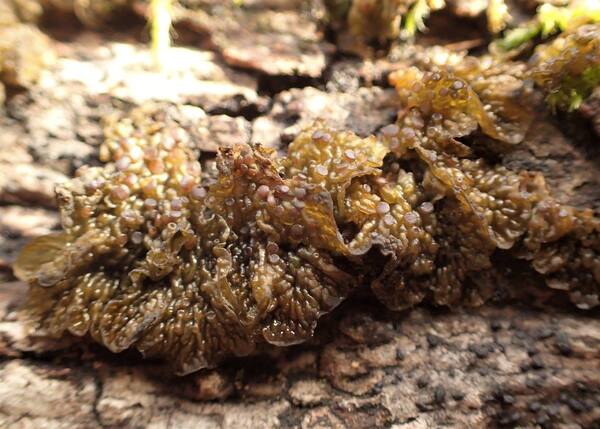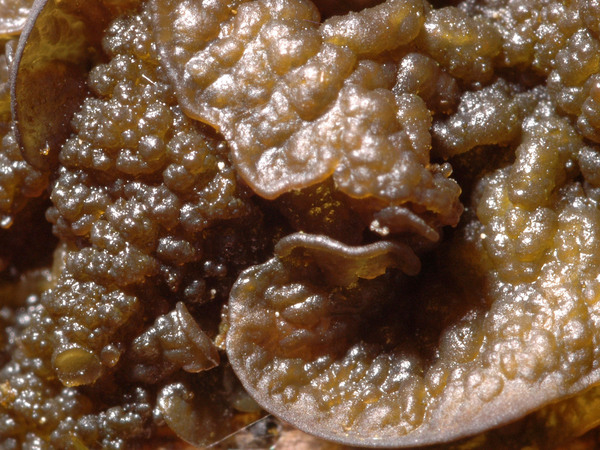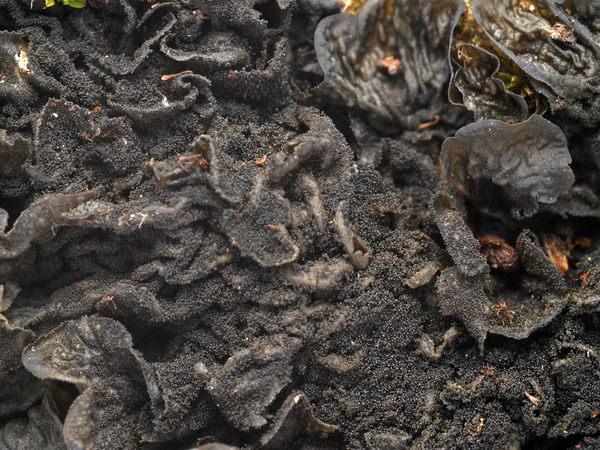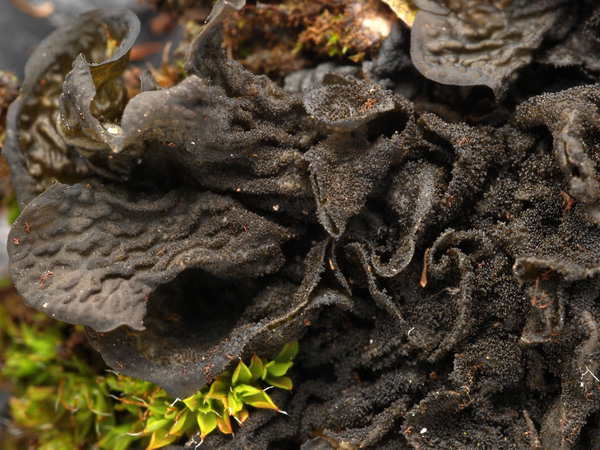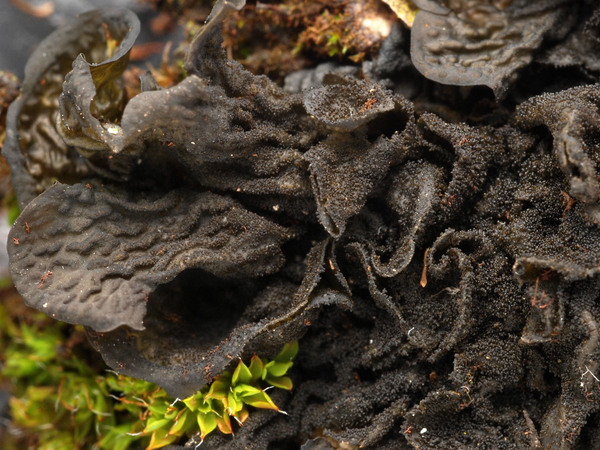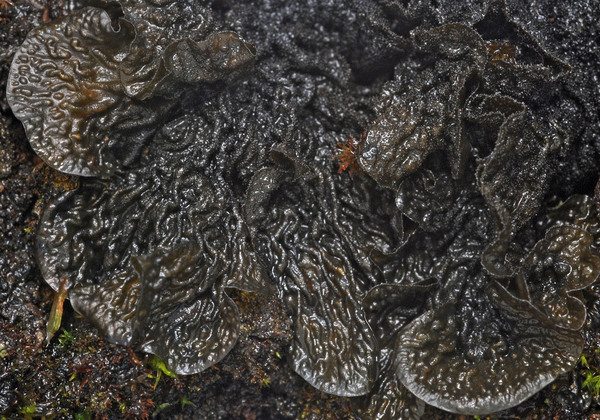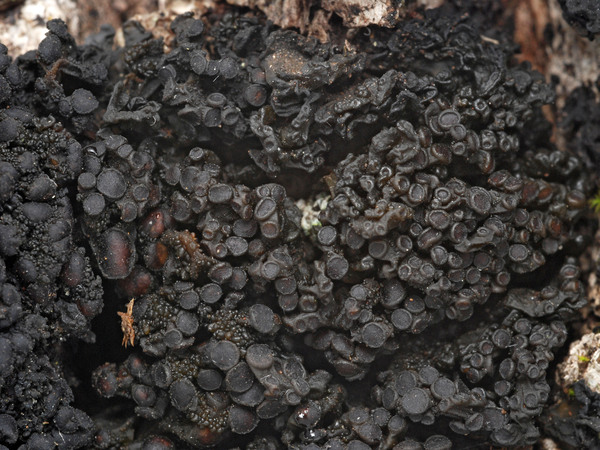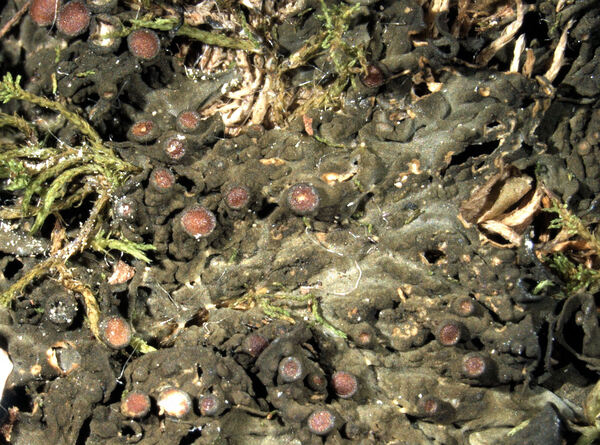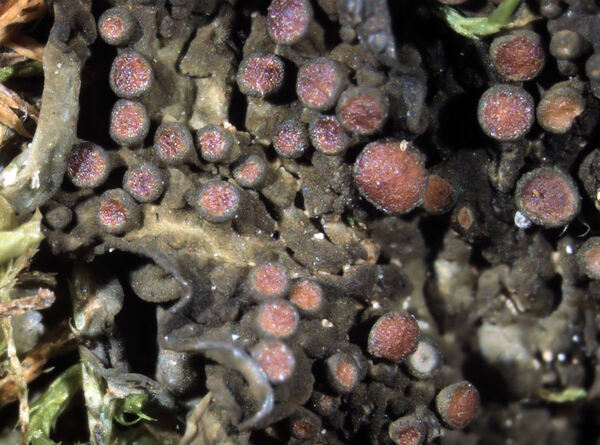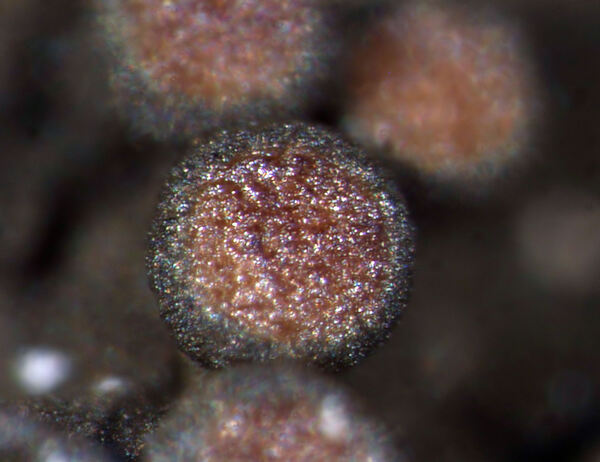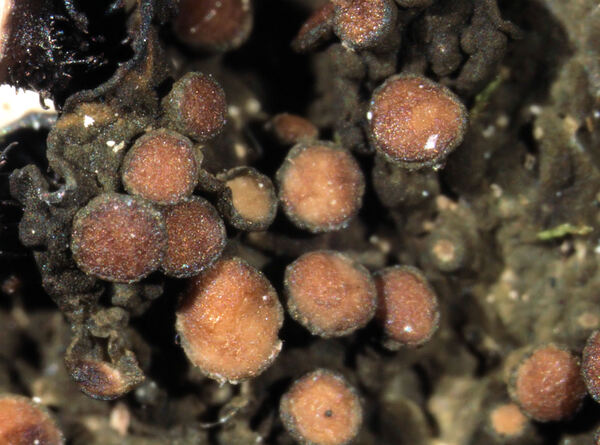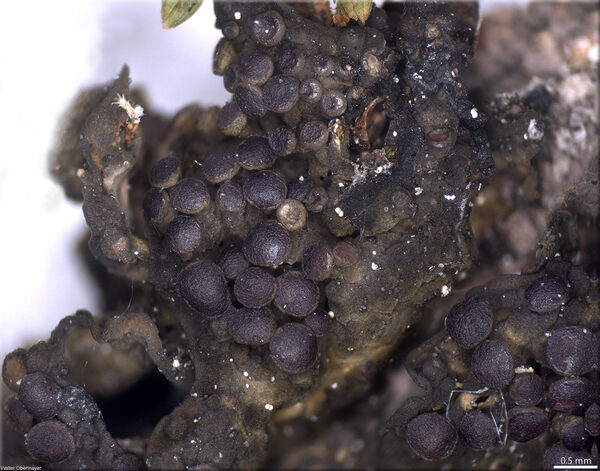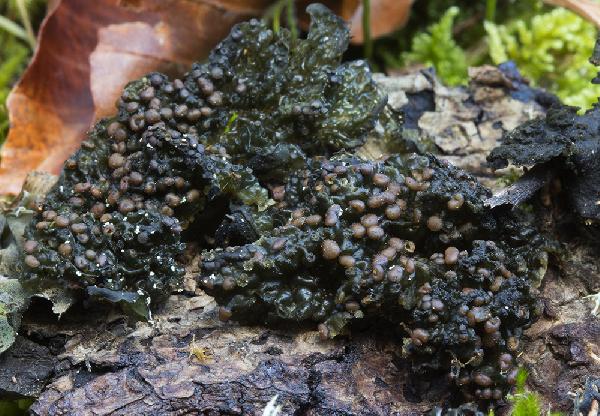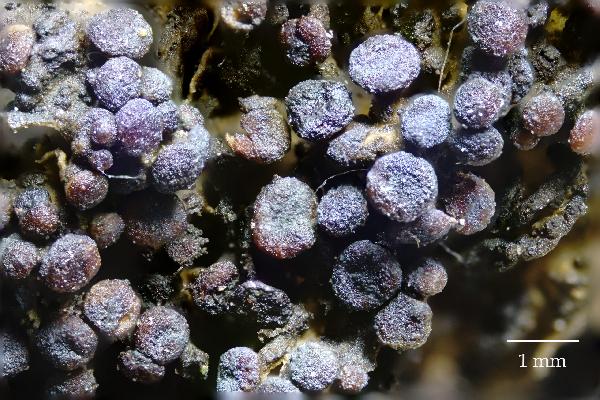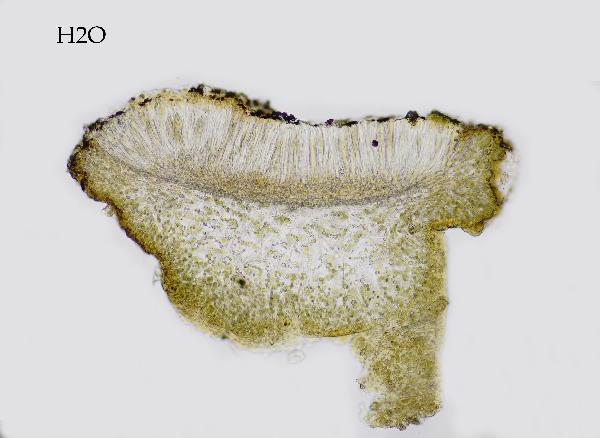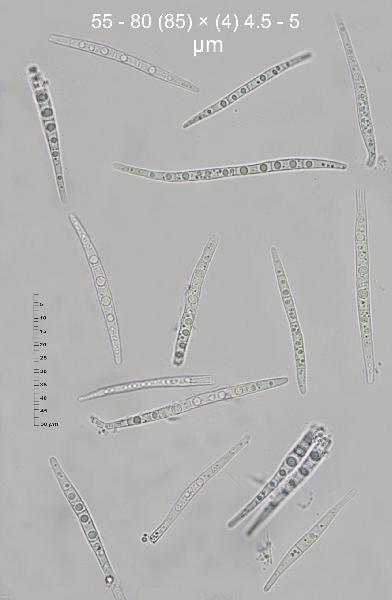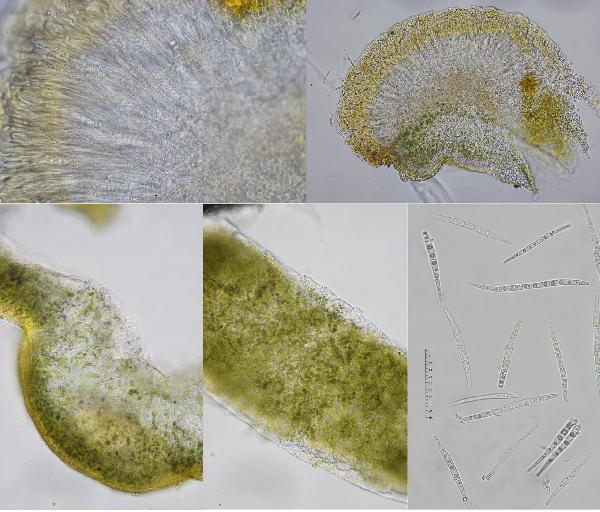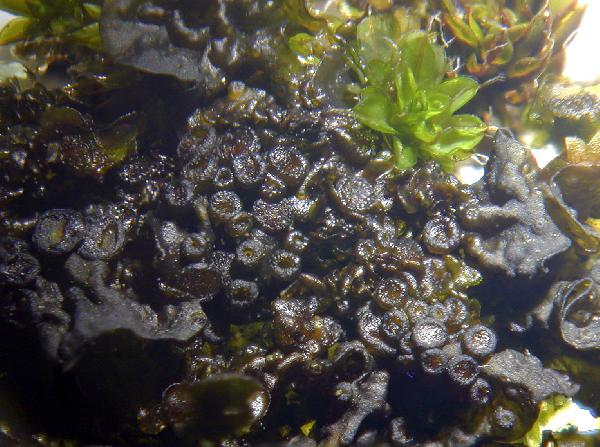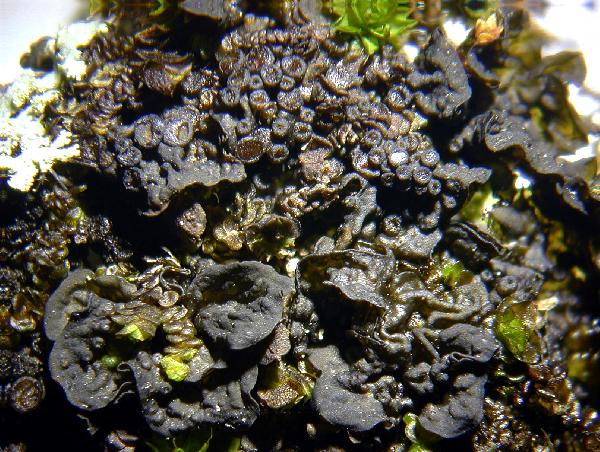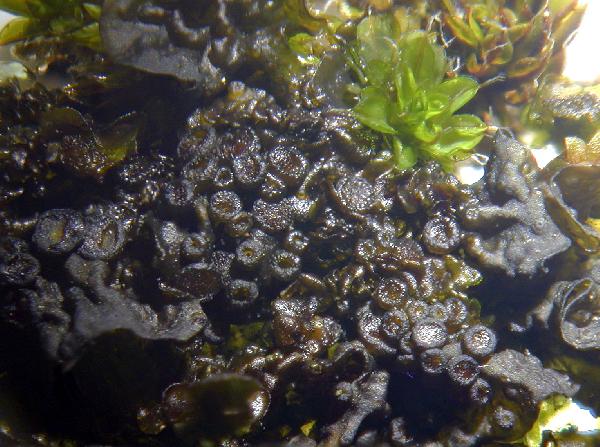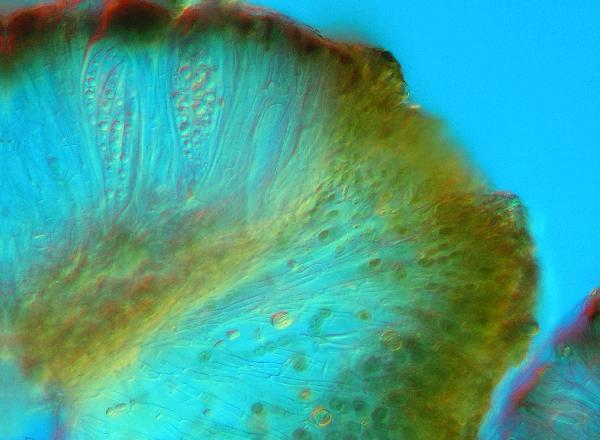Collema nigrescens (Huds.) DC.
in Lamarck & de Candolle, Fl. Franç., éd. 3, 2: 384, 1805. Basionym: Lichen nigrescens Huds. - Fl. Angl.: 450, 1762.
Synonyms: Collema nigrescens f. quinqueseptatum (Kernst.) Zahlbr.; Collema nigrescens var. rosaceum Flot.; Collema vespertilio (Lightf.) Hoffm.; Lathagrium fasciculare (L.) A. Massal.; Lathagrium nigrescens (Huds.) Gray; Lichen verspertilio Lightf. nom. illegit.; Synechoblastus nigrescens (Huds.) Trevis.; Synechoblastus nigrescens f. quinqueseptatum Kernst.; Synechoblastus vespertilio (Lightf.) Hepp
Distribution: N - VG, Frl, Ven (Caniglia & al. 1999, Nascimbene & Caniglia 2003c), TAA (Nascimbene & al. 2007b), Lomb (Valcuvia & Truzzi 2007b), Piem (Isocrono & al. 2004, Giordani & Malaspina 2016), VA (Piervittori & Isocrono 1999), Emil (Gasparo & Tretiach 1996, Benesperi 2009, Brackel 2015, Fariselli & al. 2020), Lig (Brunialti & al. 1999, Giordani & al. 2002, 2025, Brunialti & Giordani 2003, Giordani & Incerti 2008). C - Tosc (Tretiach & Nimis 1994, Loppi & al. 1998, 2002c, Putortì & al. 1998, Loppi & Frati 2006, Benesperi & al. 2007, Pasquinelli & al. 2009, Loppi & Nascimbene 2010, Benesperi 2011, Brackel 2015), Marc (Nimis & Tretiach 1999, Frati & Brunialti 2006), Umb (Ravera 1998, Ravera & al. 2006), Laz (Massari & Ravera 2002, Munzi & al. 2007, Brackel 2015), Abr (Recchia & al. 1993, Olivieri & al. 1997, 1997b, Loppi & al. 1999, Nimis & Tretiach 1999, Caporale & al. 2016, Gheza & al. 2021), Mol (Nimis & Tretiach 1999, Caporale & al. 2008, Brackel 2020, Caporale & Ravera 2020), Sar (Zedda 1995, 2002, 2002b, Zedda & al. 2001, Rizzi & al. 2011, Cossu 2013, Di Nuzzo & al. 2022). S - Camp (Aprile & al. 2003b, 2011, Nimis & Tretiach 2004, Catalano & al. 2016), Pugl (Nimis & Tretiach 1999), Bas (Nimis & Tretiach 1999, Potenza 2006, Brackel 2011), Cal (Puntillo 1995, 1996, Incerti & Nimis 2006), Si (Nimis & al. 1994, Ottonello & al. 1994, 2011, Ottonello 1996, Ottonello & Romano 1997, Schicchi & al. 1997, Grillo 1998, Grillo & Caniglia 2004, 2006, Brackel 2008b, 2008c, Ottonello & Puntillo 2009, Liistro & Cataldo 2011, Campisi & al. 2020).
Description: Thallus foliose, homoiomerous, subgelatinous when wet, membranous and adnate, broad-lobed, 1-5(-10) cm in diam. Lobes 0.5-1 cm wide, (60-)90-150 µm thick when wet, rounded and often somewhat ascending at apex, densely pustulate and coarsely ridged, dark olive-green to brown or rarely black, often pale yellowish brown in old parts. Isidioid outgrowths present or absent, granulose to slightly oblong, up to 0.2 mm wide. Lower surface greenish brown, with depressions corresponding to ridges, and scattered white hapters. Upper and lower cortices absent. Apothecia common in non-pseudoisidiate morphs, crowded (0.4-)0.6-1(-1.5) mm across, with a flat to convex, brownish red disc and an entire, often pseudoisidiate thalline margin. Thalline exciple usually pseudocorticate; proper exciple euthy- to subparaplectenchymatous; epithecium brownish; hymenium colourless, 85-110 µm high; paraphyses coherent, simple or sparingly branched, 2-3 µm thick at mid-level, the apical cells swollen; hypothecium pale yellow. Asci 8-spored, cylindrical-clavate, the apex strongly thickened, the apical dome K/I+ pale blue, with a downwardly projecting K/I+ deep blue tubular structure. Ascospores (4-)5-12-septate, hyaline, acicular to bacilliform, straight or spirally curved, 50-90(-110) x 3-4.5 µm. Pycnidia immersed or semi-immersed, on both sides of the thallus, pale. Conidia bacilliform or with slightly swollen ends, 4.5-6 x 1-1.8 µm. Photobiont cyanobacterial (Nostoc, the cells in long chains). Spot tests: all negative. Chemistry: without lichen substances.Note: a mainly temperate species found on more or less isolated trees (depending on air humidity), more common in the past, presently absent from heavily disturbed areas of the North, but locally still frequent in humid, semi-natural habitats, with optimum in Tyrrhenian Italy; the species is more wide-ranging in altitude and latitude than the closely related C. subnigrescens. The recent record from Tuscany by Pasquinelli & Puccini (2010), judging from the pictures and the description, is certainly wrong.
Growth form: Foliose, broad lobed
Substrata: bark
Photobiont: cyanobacteria, filamentous (e.g. Nostoc, Scytonema)
Reproductive strategy: mainly asexual, by isidia, or isidia-like structures (e.g. schizidia)
Most common in areas with a humid-warm climate (e.g. most of Tyrrenian Italy)
Commonnes-rarity: (info)
Alpine belt: absent
Subalpine belt: absent
Oromediterranean belt: absent
Montane belt: extremely rare
Submediterranean belt: very rare
Padanian area: absent
Humid submediterranean belt: rather common
Humid mediterranean belt: common
Dry mediterranean belt: absent

Predictive model
Herbarium samples
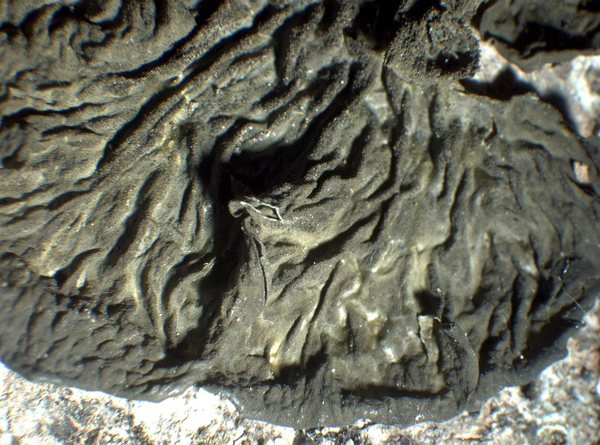

P.L.Nimis; Owner: Department of Life Sciences, University of Trieste
Herbarium: TSB (36982)
2008.02.25
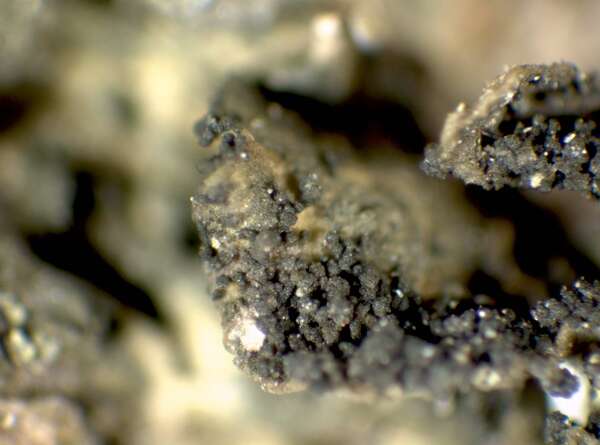

P.L. Nimis; Owner: Department of Life Sciences, University of Trieste
Herbarium: TSB (27109)
2001/12/04
detail of isidia
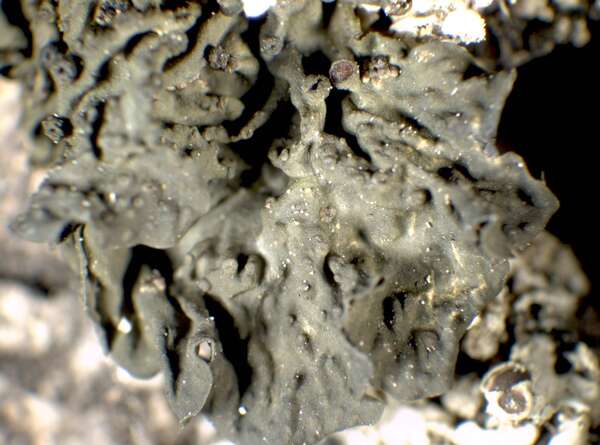

P.L. Nimis; Owner: Department of Life Sciences, University of Trieste
Herbarium: TSB (9785)
2001/12/04
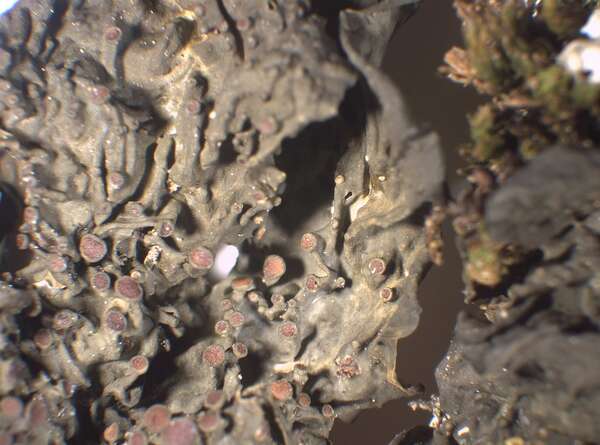

P.L. Nimis; Owner: Department of Life Sciences, University of Trieste
Herbarium: TSB (30652)
2002/12/03
fertile specimen
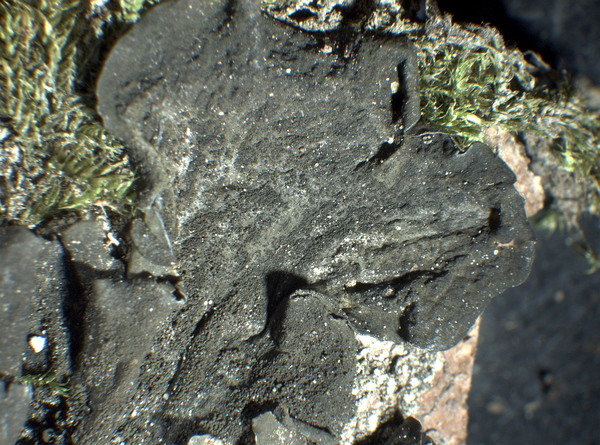

P.L.Nimis; Owner: Department of Life Sciences, University of Trieste
Herbarium: TSB (36982)
2008.02.25
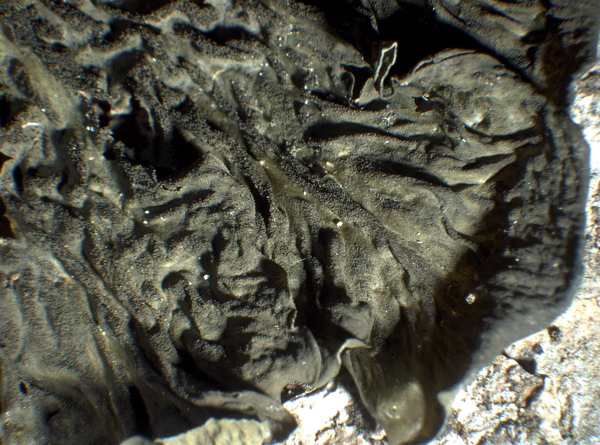

P.L.Nimis; Owner: Department of Life Sciences, University of Trieste
Herbarium: TSB (36982)
2008.02.25
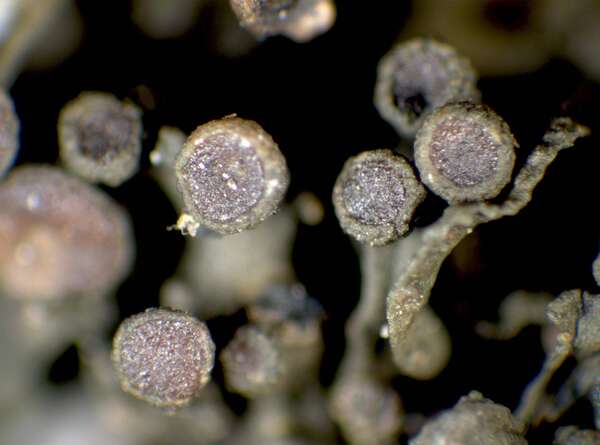

P.L. Nimis; Owner: Department of Life Sciences, University of Trieste
Herbarium: TSB (9785)
2001/12/04
detail of apothecia
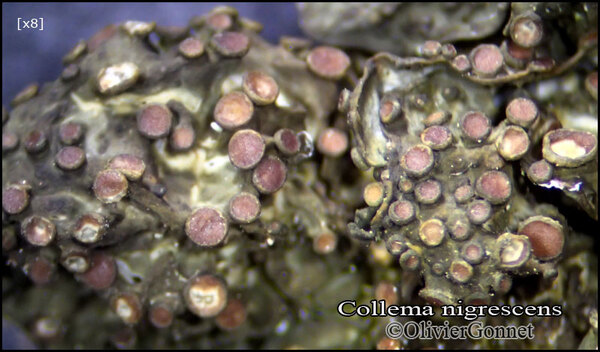
Courtesy Danièle et Olivier Gonnet - Source: https://www.afl-lichenologie.fr/Photos_AFL/Photos_AFL_C/Textes_C5/Collema_nigrescens.htm; Owner: -
France, Entremont-Le-Vieux - Savoie
8/2/2014
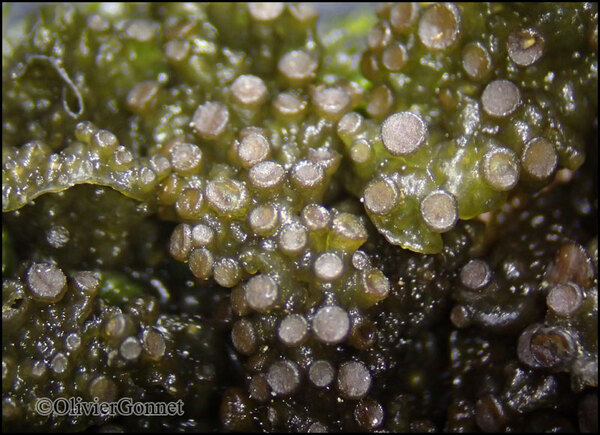
Courtesy Danièle et Olivier Gonnet - Source: https://www.afl-lichenologie.fr/Photos_AFL/Photos_AFL_C/Textes_C5/Collema_nigrescens.htm; Owner: -
France, Entremont-Le-Vieux - Savoie
8/2/2014

Courtesy Danièle et Olivier Gonnet - Source: https://www.afl-lichenologie.fr/Photos_AFL/Photos_AFL_C/Textes_C5/Collema_nigrescens.htm; Owner: -
France, Entremont-Le-Vieux - Savoie
8/2/2014
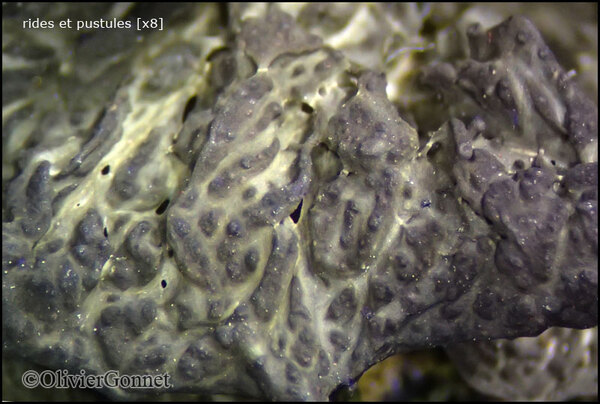
Courtesy Danièle et Olivier Gonnet - Source: https://www.afl-lichenologie.fr/Photos_AFL/Photos_AFL_C/Textes_C5/Collema_nigrescens.htm; Owner: -
France, Entremont-Le-Vieux - Savoie
8/2/2014
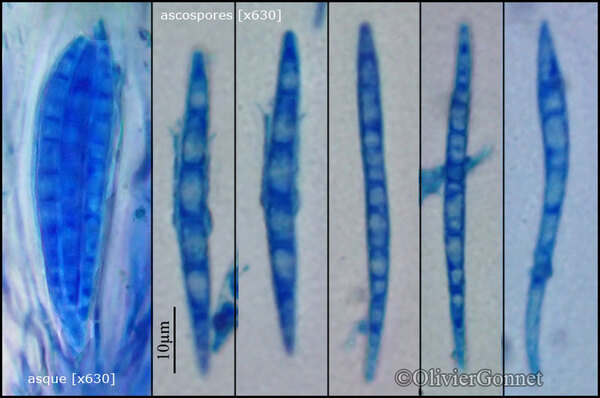
Courtesy Danièle et Olivier Gonnet - Source: https://www.afl-lichenologie.fr/Photos_AFL/Photos_AFL_C/Textes_C5/Collema_nigrescens.htm; Owner: -
France, Entremont-Le-Vieux - Savoie
8/2/2014

Bernard Bouffinier - Source: http://www.lichensmaritimes.org/index.php?task=fiche&lichen=337&lang=en
France, Crozon

Bernard Bouffinier - Source: http://www.lichensmaritimes.org/index.php?task=fiche&lichen=337&lang=en
France, Crozon
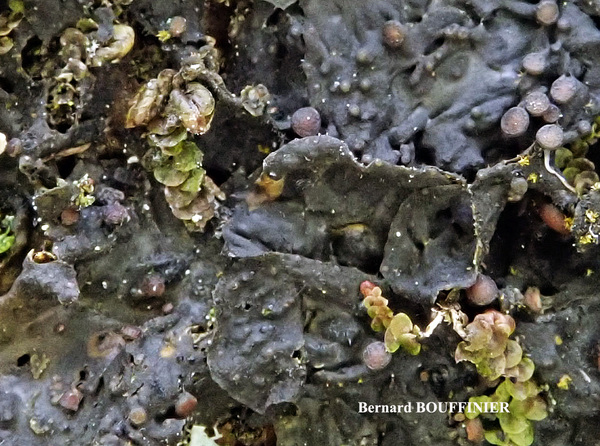
Bernard Bouffinier - Source: http://www.lichensmaritimes.org/index.php?task=fiche&lichen=337&lang=en
France, Crozon
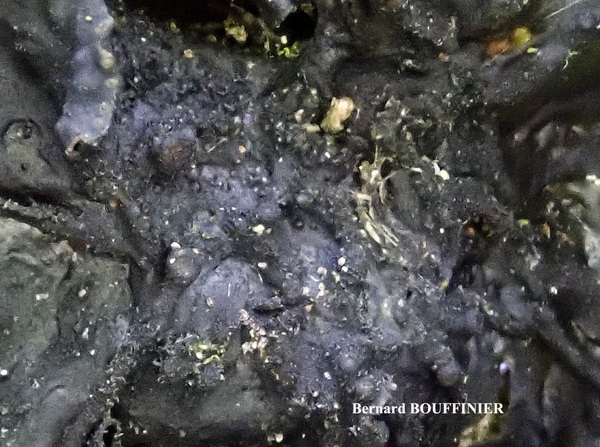
Bernard Bouffinier - Source: http://www.lichensmaritimes.org/index.php?task=fiche&lichen=337&lang=en
France, Crozon
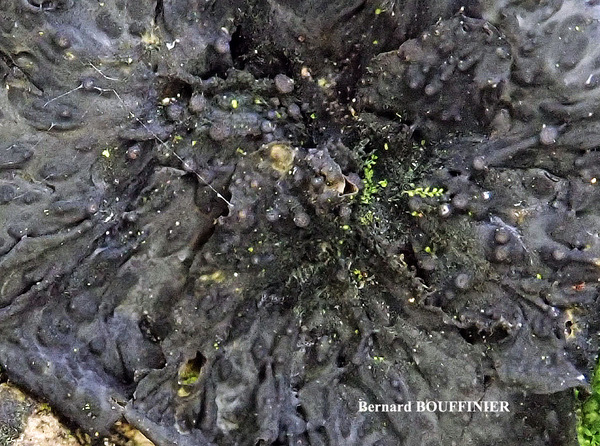
Bernard Bouffinier - Source: http://www.lichensmaritimes.org/index.php?task=fiche&lichen=337&lang=en
France, Crozon

Bernard Bouffinier - Source: http://www.lichensmaritimes.org/index.php?task=fiche&lichen=337&lang=en
France, Dineault

Bernard Bouffinier - Source: http://www.lichensmaritimes.org/index.php?task=fiche&lichen=337&lang=en
France, Lostmarc'h
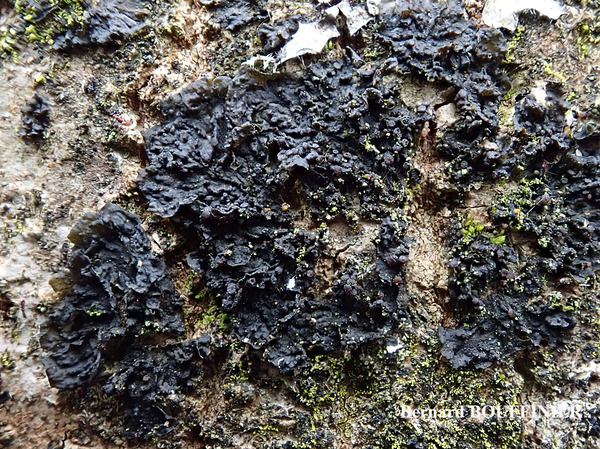
Bernard Bouffinier - Source: http://www.lichensmaritimes.org/index.php?task=fiche&lichen=337&lang=en
France, Lostmarc'h
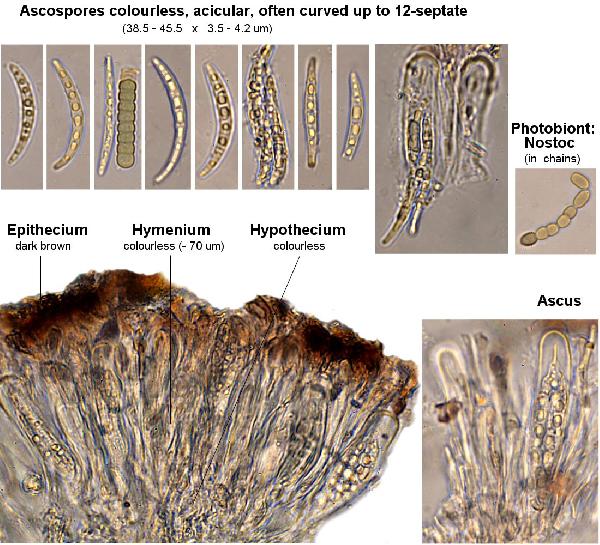
Ulrich Kirschbaum CC BY-SA 4.0 - Source: https://www.thm.de/lse/ulrich-kirschbaum/flechtenbilder
Canary Islands; La Gomera-MSW; ese of Chipude: hiking path between Fortaleza and Igualero; se of the little brook.

Ulrich Kirschbaum CC BY-SA 4.0 - Source: https://www.thm.de/lse/ulrich-kirschbaum/flechtenbilder
Central Europe; Germany; Bavaria: Allgäu.
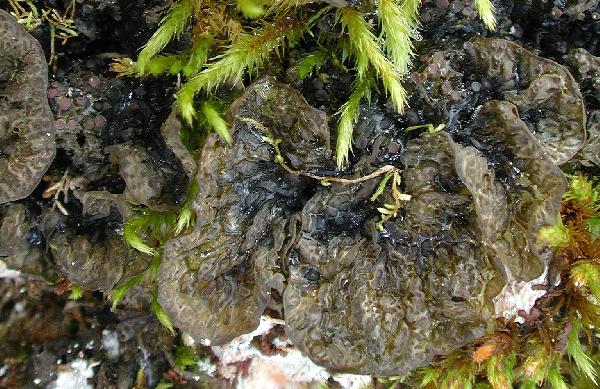
Ulrich Kirschbaum CC BY-SA 4.0 - Source: https://www.thm.de/lse/ulrich-kirschbaum/flechtenbilder
Austria: Alps.
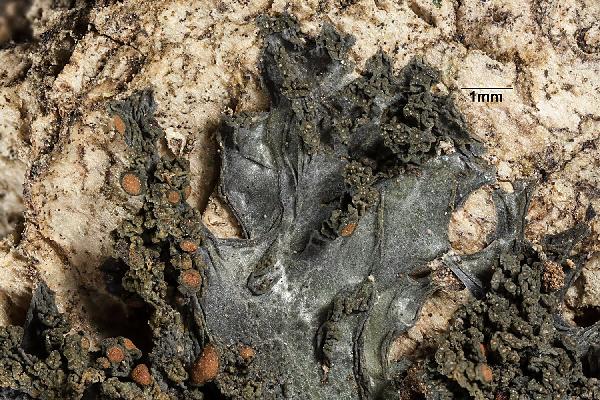
Ulrich Kirschbaum CC BY-SA 4.0 - Source: https://www.thm.de/lse/ulrich-kirschbaum/flechtenbilder
On Castanea sativa. Portugal, Madeira.
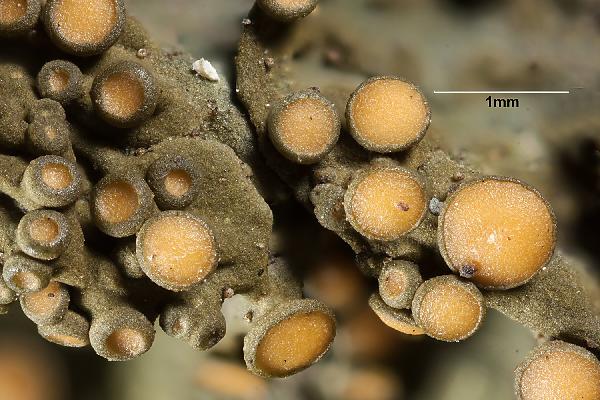
Ulrich Kirschbaum CC BY-SA 4.0 - Source: https://www.thm.de/lse/ulrich-kirschbaum/flechtenbilder
On Castanea sativa. Portugal, Madeira.
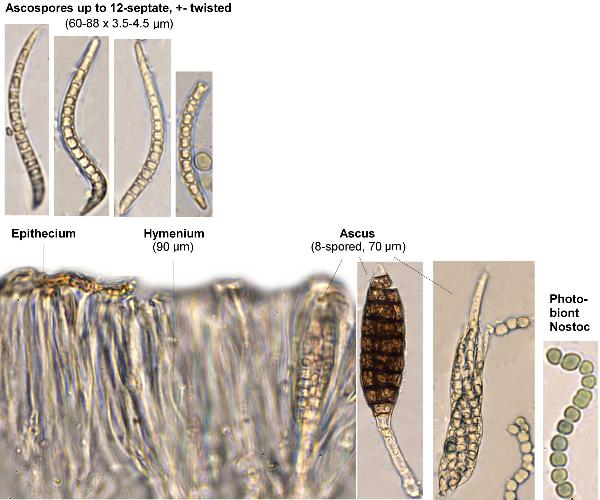
Ulrich Kirschbaum CC BY-SA 4.0 - Source: https://www.thm.de/lse/ulrich-kirschbaum/flechtenbilder
On Castanea sativa. Portugal, Madeira.


Felix Schumm - CC BY-SA 4.0
[2065], Schweiz, Herrenrüti, östlich von Engelberg (679/183), ca.
1170-1250 m, an Acer pseudoplatanus. Leg. F. Schumm. 04.09.1972,
det. F. Schumm
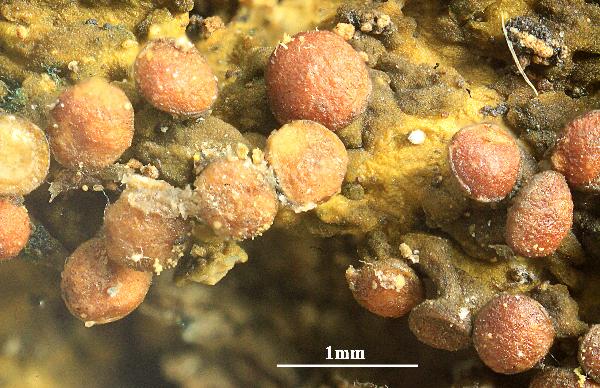

Felix Schumm - CC BY-SA 4.0
[2065], Schweiz, Herrenrüti, östlich von Engelberg (679/183), ca.
1170-1250 m, an Acer pseudoplatanus. Leg. F. Schumm. 04.09.1972,
det. F. Schumm
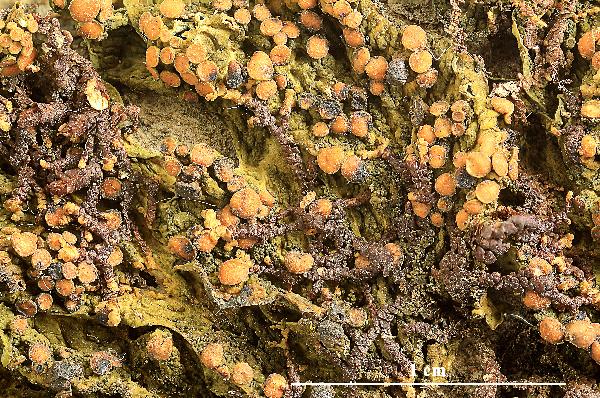

Felix Schumm - CC BY-SA 4.0
[2909], Nordjugoslawien, Slowenien: koloniebildend an glatten moosigen
Borkenschollen der halbschattigen Mittelstämme älterer Laubbäume
im Physcietum ascendentis Frey et Ochsner., 1200 m, pH 6.0;
NO-SO; feuchtgetönter regenreicher Kalkbuchenwald am Nordhang
des Vogel in den Julischen Alpen. Leg. G. Follmann, 07.1980, det. A.
Henssen 02.1982. - Ex G. FOLLMANN: LICHENES . EXSICCATI SELECTI
A MUSEO HISTORIAE NATURALIS CASSELENSI EDITI NR. 364.


Felix Schumm - CC BY-SA 4.0
[2909], Nordjugoslawien, Slowenien: koloniebildend an glatten moosigen
Borkenschollen der halbschattigen Mittelstämme älterer Laubbäume
im Physcietum ascendentis Frey et Ochsner., 1200 m, pH 6.0;
NO-SO; feuchtgetönter regenreicher Kalkbuchenwald am Nordhang
des Vogel in den Julischen Alpen. Leg. G. Follmann, 07.1980, det. A.
Henssen 02.1982. - Ex G. FOLLMANN: LICHENES . EXSICCATI SELECTI
A MUSEO HISTORIAE NATURALIS CASSELENSI EDITI NR. 364.
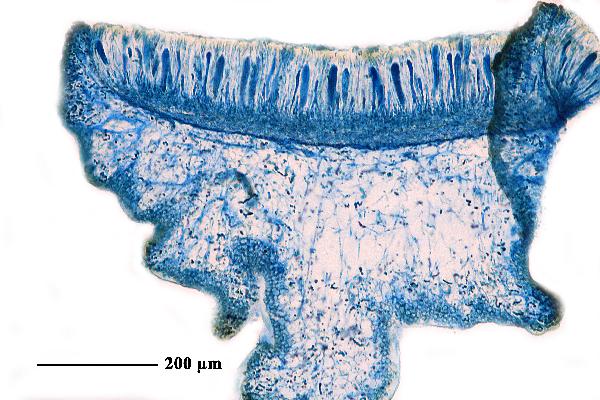

Felix Schumm - CC BY-SA 4.0
[2909], Nordjugoslawien, Slowenien: koloniebildend an glatten moosigen
Borkenschollen der halbschattigen Mittelstämme älterer Laubbäume
im Physcietum ascendentis Frey et Ochsner., 1200 m, pH 6.0;
NO-SO; feuchtgetönter regenreicher Kalkbuchenwald am Nordhang
des Vogel in den Julischen Alpen. Leg. G. Follmann, 07.1980, det. A.
Henssen 02.1982. - Ex G. FOLLMANN: LICHENES . EXSICCATI SELECTI
A MUSEO HISTORIAE NATURALIS CASSELENSI EDITI NR. 364.
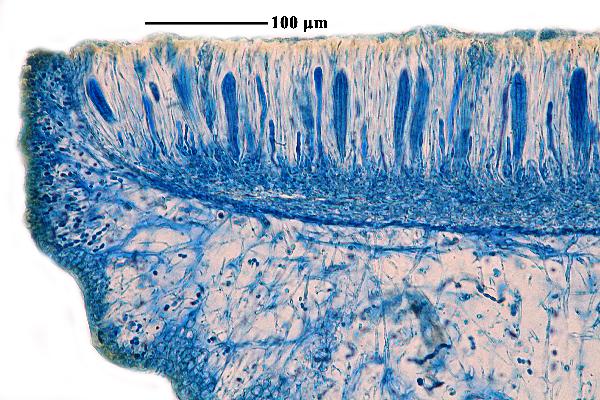

Felix Schumm - CC BY-SA 4.0
[2909], Nordjugoslawien, Slowenien: koloniebildend an glatten moosigen
Borkenschollen der halbschattigen Mittelstämme älterer Laubbäume
im Physcietum ascendentis Frey et Ochsner., 1200 m, pH 6.0;
NO-SO; feuchtgetönter regenreicher Kalkbuchenwald am Nordhang
des Vogel in den Julischen Alpen. Leg. G. Follmann, 07.1980, det. A.
Henssen 02.1982. - Ex G. FOLLMANN: LICHENES . EXSICCATI SELECTI
A MUSEO HISTORIAE NATURALIS CASSELENSI EDITI NR. 364.
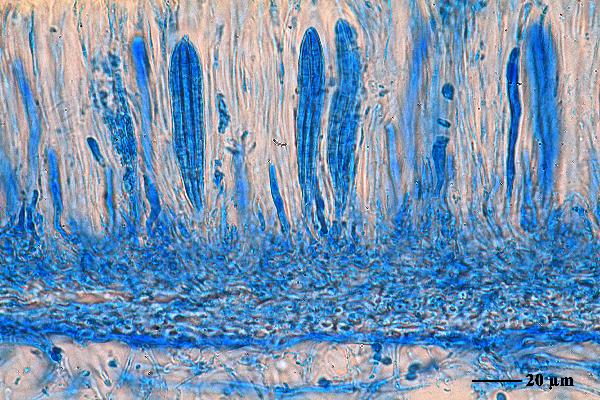

Felix Schumm - CC BY-SA 4.0
[2909], Nordjugoslawien, Slowenien: koloniebildend an glatten moosigen
Borkenschollen der halbschattigen Mittelstämme älterer Laubbäume
im Physcietum ascendentis Frey et Ochsner., 1200 m, pH 6.0;
NO-SO; feuchtgetönter regenreicher Kalkbuchenwald am Nordhang
des Vogel in den Julischen Alpen. Leg. G. Follmann, 07.1980, det. A.
Henssen 02.1982. - Ex G. FOLLMANN: LICHENES . EXSICCATI SELECTI
A MUSEO HISTORIAE NATURALIS CASSELENSI EDITI NR. 364.
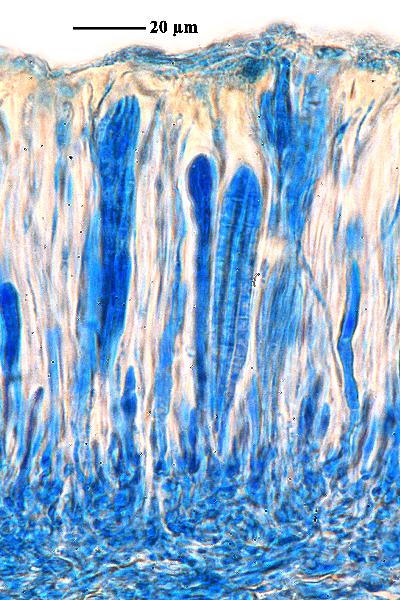

Felix Schumm - CC BY-SA 4.0
[2909], Nordjugoslawien, Slowenien: koloniebildend an glatten moosigen
Borkenschollen der halbschattigen Mittelstämme älterer Laubbäume
im Physcietum ascendentis Frey et Ochsner., 1200 m, pH 6.0;
NO-SO; feuchtgetönter regenreicher Kalkbuchenwald am Nordhang
des Vogel in den Julischen Alpen. Leg. G. Follmann, 07.1980, det. A.
Henssen 02.1982. - Ex G. FOLLMANN: LICHENES . EXSICCATI SELECTI
A MUSEO HISTORIAE NATURALIS CASSELENSI EDITI NR. 364.
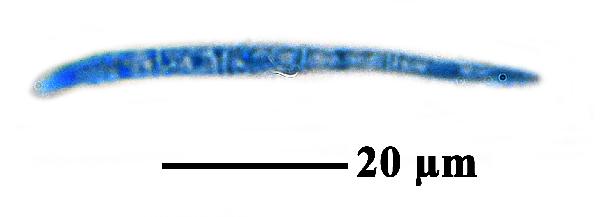

Felix Schumm - CC BY-SA 4.0
[2909], Nordjugoslawien, Slowenien: koloniebildend an glatten moosigen
Borkenschollen der halbschattigen Mittelstämme älterer Laubbäume
im Physcietum ascendentis Frey et Ochsner., 1200 m, pH 6.0;
NO-SO; feuchtgetönter regenreicher Kalkbuchenwald am Nordhang
des Vogel in den Julischen Alpen. Leg. G. Follmann, 07.1980, det. A.
Henssen 02.1982. - Ex G. FOLLMANN: LICHENES . EXSICCATI SELECTI
A MUSEO HISTORIAE NATURALIS CASSELENSI EDITI NR. 364.
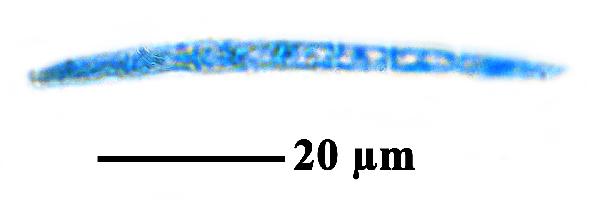

Felix Schumm - CC BY-SA 4.0
[2909], Nordjugoslawien, Slowenien: koloniebildend an glatten moosigen
Borkenschollen der halbschattigen Mittelstämme älterer Laubbäume
im Physcietum ascendentis Frey et Ochsner., 1200 m, pH 6.0;
NO-SO; feuchtgetönter regenreicher Kalkbuchenwald am Nordhang
des Vogel in den Julischen Alpen. Leg. G. Follmann, 07.1980, det. A.
Henssen 02.1982. - Ex G. FOLLMANN: LICHENES . EXSICCATI SELECTI
A MUSEO HISTORIAE NATURALIS CASSELENSI EDITI NR. 364.


Felix Schumm - CC BY-SA 4.0
[2909], Nordjugoslawien, Slowenien: koloniebildend an glatten moosigen
Borkenschollen der halbschattigen Mittelstämme älterer Laubbäume
im Physcietum ascendentis Frey et Ochsner., 1200 m, pH 6.0;
NO-SO; feuchtgetönter regenreicher Kalkbuchenwald am Nordhang
des Vogel in den Julischen Alpen. Leg. G. Follmann, 07.1980, det. A.
Henssen 02.1982. - Ex G. FOLLMANN: LICHENES . EXSICCATI SELECTI
A MUSEO HISTORIAE NATURALIS CASSELENSI EDITI NR. 364.
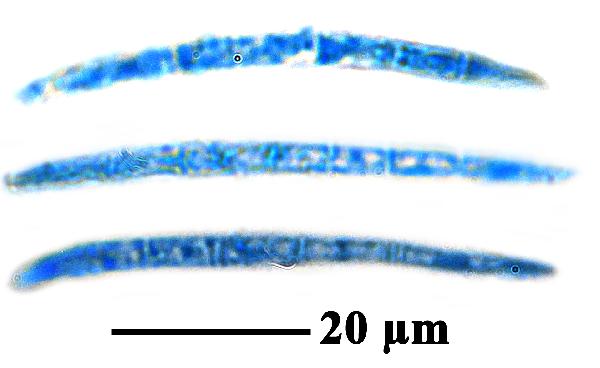

Felix Schumm - CC BY-SA 4.0
[2909], Nordjugoslawien, Slowenien: koloniebildend an glatten moosigen
Borkenschollen der halbschattigen Mittelstämme älterer Laubbäume
im Physcietum ascendentis Frey et Ochsner., 1200 m, pH 6.0;
NO-SO; feuchtgetönter regenreicher Kalkbuchenwald am Nordhang
des Vogel in den Julischen Alpen. Leg. G. Follmann, 07.1980, det. A.
Henssen 02.1982. - Ex G. FOLLMANN: LICHENES . EXSICCATI SELECTI
A MUSEO HISTORIAE NATURALIS CASSELENSI EDITI NR. 364.
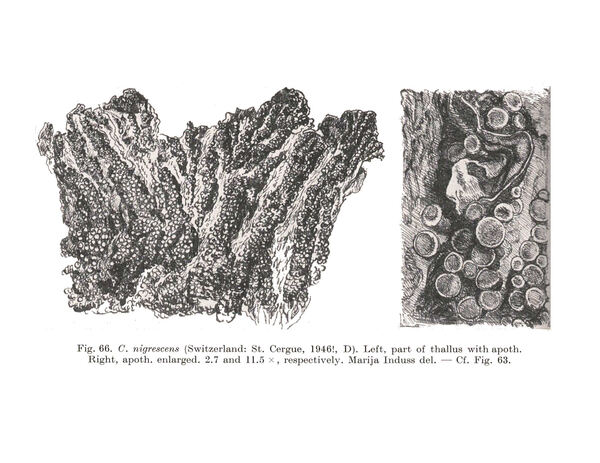
Degelius G. 1954. The lichen genus Collema in Europe: Morphology, Taxonomy, Ecology. Symbolae Bot. Upsal. 13, 2: 1-499.

Collezione lichenologica Abramo Massalongo del Museo di Storia Naturale G. Ligabue di Venezia - Autori: Seggi, Linda; Trabucco, Raffaella Proprietà: Fondazione Musei Civici di Venezia - CC BY-NC
Italy, Veneto, in op. [Tregnago]
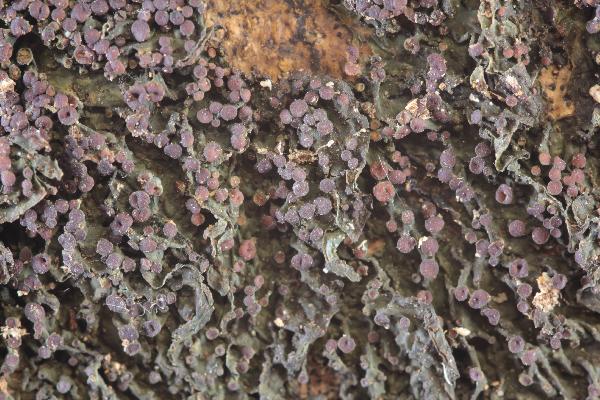
Collezione lichenologica Abramo Massalongo del Museo di Storia Naturale G. Ligabue di Venezia - Autori: Seggi, Linda; Trabucco, Raffaella Proprietà: Fondazione Musei Civici di Venezia - CC BY-NC
Italy, Veneto, ad Fraxinos in op. Tremniaco vulgo Tregnago Pr. Ver. 1855
As Letagrium nigrescens

Collezione lichenologica Abramo Massalongo del Museo di Storia Naturale G. Ligabue di Venezia - Autori: Seggi, Linda; Trabucco, Raffaella Proprietà: Fondazione Musei Civici di Venezia - CC BY-NC
Italy, Veneto, in Op. Tregnago
As Letagrium nigrescens
Growth form: Foliose, broad lobed
Substrata: bark
Photobiont: cyanobacteria, filamentous (e.g. Nostoc, Scytonema)
Reproductive strategy: mainly asexual, by isidia, or isidia-like structures (e.g. schizidia)
Most common in areas with a humid-warm climate (e.g. most of Tyrrenian Italy)
Commonnes-rarity: (info)
Alpine belt: absent
Subalpine belt: absent
Oromediterranean belt: absent
Montane belt: extremely rare
Submediterranean belt: very rare
Padanian area: absent
Humid submediterranean belt: rather common
Humid mediterranean belt: common
Dry mediterranean belt: absent

Predictive model
| Herbarium samples |


P.L.Nimis; Owner: Department of Life Sciences, University of Trieste
Herbarium: TSB (36982)
2008.02.25


P.L. Nimis; Owner: Department of Life Sciences, University of Trieste
Herbarium: TSB (27109)
2001/12/04
detail of isidia


P.L. Nimis; Owner: Department of Life Sciences, University of Trieste
Herbarium: TSB (9785)
2001/12/04


P.L. Nimis; Owner: Department of Life Sciences, University of Trieste
Herbarium: TSB (30652)
2002/12/03
fertile specimen


P.L.Nimis; Owner: Department of Life Sciences, University of Trieste
Herbarium: TSB (36982)
2008.02.25


P.L.Nimis; Owner: Department of Life Sciences, University of Trieste
Herbarium: TSB (36982)
2008.02.25


P.L. Nimis; Owner: Department of Life Sciences, University of Trieste
Herbarium: TSB (9785)
2001/12/04
detail of apothecia

Courtesy Danièle et Olivier Gonnet - Source: https://www.afl-lichenologie.fr/Photos_AFL/Photos_AFL_C/Textes_C5/Collema_nigrescens.htm; Owner: -
France, Entremont-Le-Vieux - Savoie
8/2/2014

Courtesy Danièle et Olivier Gonnet - Source: https://www.afl-lichenologie.fr/Photos_AFL/Photos_AFL_C/Textes_C5/Collema_nigrescens.htm; Owner: -
France, Entremont-Le-Vieux - Savoie
8/2/2014

Courtesy Danièle et Olivier Gonnet - Source: https://www.afl-lichenologie.fr/Photos_AFL/Photos_AFL_C/Textes_C5/Collema_nigrescens.htm; Owner: -
France, Entremont-Le-Vieux - Savoie
8/2/2014

Courtesy Danièle et Olivier Gonnet - Source: https://www.afl-lichenologie.fr/Photos_AFL/Photos_AFL_C/Textes_C5/Collema_nigrescens.htm; Owner: -
France, Entremont-Le-Vieux - Savoie
8/2/2014

Courtesy Danièle et Olivier Gonnet - Source: https://www.afl-lichenologie.fr/Photos_AFL/Photos_AFL_C/Textes_C5/Collema_nigrescens.htm; Owner: -
France, Entremont-Le-Vieux - Savoie
8/2/2014

Bernard Bouffinier - Source: http://www.lichensmaritimes.org/index.php?task=fiche&lichen=337&lang=en
France, Crozon

Bernard Bouffinier - Source: http://www.lichensmaritimes.org/index.php?task=fiche&lichen=337&lang=en
France, Crozon

Bernard Bouffinier - Source: http://www.lichensmaritimes.org/index.php?task=fiche&lichen=337&lang=en
France, Crozon

Bernard Bouffinier - Source: http://www.lichensmaritimes.org/index.php?task=fiche&lichen=337&lang=en
France, Crozon

Bernard Bouffinier - Source: http://www.lichensmaritimes.org/index.php?task=fiche&lichen=337&lang=en
France, Crozon

Bernard Bouffinier - Source: http://www.lichensmaritimes.org/index.php?task=fiche&lichen=337&lang=en
France, Dineault

Bernard Bouffinier - Source: http://www.lichensmaritimes.org/index.php?task=fiche&lichen=337&lang=en
France, Lostmarc'h

Bernard Bouffinier - Source: http://www.lichensmaritimes.org/index.php?task=fiche&lichen=337&lang=en
France, Lostmarc'h

Ulrich Kirschbaum CC BY-SA 4.0 - Source: https://www.thm.de/lse/ulrich-kirschbaum/flechtenbilder
Canary Islands; La Gomera-MSW; ese of Chipude: hiking path between Fortaleza and Igualero; se of the little brook.

Ulrich Kirschbaum CC BY-SA 4.0 - Source: https://www.thm.de/lse/ulrich-kirschbaum/flechtenbilder
Central Europe; Germany; Bavaria: Allgäu.

Ulrich Kirschbaum CC BY-SA 4.0 - Source: https://www.thm.de/lse/ulrich-kirschbaum/flechtenbilder
Austria: Alps.

Ulrich Kirschbaum CC BY-SA 4.0 - Source: https://www.thm.de/lse/ulrich-kirschbaum/flechtenbilder
On Castanea sativa. Portugal, Madeira.

Ulrich Kirschbaum CC BY-SA 4.0 - Source: https://www.thm.de/lse/ulrich-kirschbaum/flechtenbilder
On Castanea sativa. Portugal, Madeira.

Ulrich Kirschbaum CC BY-SA 4.0 - Source: https://www.thm.de/lse/ulrich-kirschbaum/flechtenbilder
On Castanea sativa. Portugal, Madeira.


Felix Schumm - CC BY-SA 4.0
[2065], Schweiz, Herrenrüti, östlich von Engelberg (679/183), ca. 1170-1250 m, an Acer pseudoplatanus. Leg. F. Schumm. 04.09.1972, det. F. Schumm


Felix Schumm - CC BY-SA 4.0
[2065], Schweiz, Herrenrüti, östlich von Engelberg (679/183), ca. 1170-1250 m, an Acer pseudoplatanus. Leg. F. Schumm. 04.09.1972, det. F. Schumm


Felix Schumm - CC BY-SA 4.0
[2909], Nordjugoslawien, Slowenien: koloniebildend an glatten moosigen Borkenschollen der halbschattigen Mittelstämme älterer Laubbäume im Physcietum ascendentis Frey et Ochsner., 1200 m, pH 6.0; NO-SO; feuchtgetönter regenreicher Kalkbuchenwald am Nordhang des Vogel in den Julischen Alpen. Leg. G. Follmann, 07.1980, det. A. Henssen 02.1982. - Ex G. FOLLMANN: LICHENES . EXSICCATI SELECTI A MUSEO HISTORIAE NATURALIS CASSELENSI EDITI NR. 364.


Felix Schumm - CC BY-SA 4.0
[2909], Nordjugoslawien, Slowenien: koloniebildend an glatten moosigen Borkenschollen der halbschattigen Mittelstämme älterer Laubbäume im Physcietum ascendentis Frey et Ochsner., 1200 m, pH 6.0; NO-SO; feuchtgetönter regenreicher Kalkbuchenwald am Nordhang des Vogel in den Julischen Alpen. Leg. G. Follmann, 07.1980, det. A. Henssen 02.1982. - Ex G. FOLLMANN: LICHENES . EXSICCATI SELECTI A MUSEO HISTORIAE NATURALIS CASSELENSI EDITI NR. 364.


Felix Schumm - CC BY-SA 4.0
[2909], Nordjugoslawien, Slowenien: koloniebildend an glatten moosigen Borkenschollen der halbschattigen Mittelstämme älterer Laubbäume im Physcietum ascendentis Frey et Ochsner., 1200 m, pH 6.0; NO-SO; feuchtgetönter regenreicher Kalkbuchenwald am Nordhang des Vogel in den Julischen Alpen. Leg. G. Follmann, 07.1980, det. A. Henssen 02.1982. - Ex G. FOLLMANN: LICHENES . EXSICCATI SELECTI A MUSEO HISTORIAE NATURALIS CASSELENSI EDITI NR. 364.


Felix Schumm - CC BY-SA 4.0
[2909], Nordjugoslawien, Slowenien: koloniebildend an glatten moosigen Borkenschollen der halbschattigen Mittelstämme älterer Laubbäume im Physcietum ascendentis Frey et Ochsner., 1200 m, pH 6.0; NO-SO; feuchtgetönter regenreicher Kalkbuchenwald am Nordhang des Vogel in den Julischen Alpen. Leg. G. Follmann, 07.1980, det. A. Henssen 02.1982. - Ex G. FOLLMANN: LICHENES . EXSICCATI SELECTI A MUSEO HISTORIAE NATURALIS CASSELENSI EDITI NR. 364.


Felix Schumm - CC BY-SA 4.0
[2909], Nordjugoslawien, Slowenien: koloniebildend an glatten moosigen Borkenschollen der halbschattigen Mittelstämme älterer Laubbäume im Physcietum ascendentis Frey et Ochsner., 1200 m, pH 6.0; NO-SO; feuchtgetönter regenreicher Kalkbuchenwald am Nordhang des Vogel in den Julischen Alpen. Leg. G. Follmann, 07.1980, det. A. Henssen 02.1982. - Ex G. FOLLMANN: LICHENES . EXSICCATI SELECTI A MUSEO HISTORIAE NATURALIS CASSELENSI EDITI NR. 364.


Felix Schumm - CC BY-SA 4.0
[2909], Nordjugoslawien, Slowenien: koloniebildend an glatten moosigen Borkenschollen der halbschattigen Mittelstämme älterer Laubbäume im Physcietum ascendentis Frey et Ochsner., 1200 m, pH 6.0; NO-SO; feuchtgetönter regenreicher Kalkbuchenwald am Nordhang des Vogel in den Julischen Alpen. Leg. G. Follmann, 07.1980, det. A. Henssen 02.1982. - Ex G. FOLLMANN: LICHENES . EXSICCATI SELECTI A MUSEO HISTORIAE NATURALIS CASSELENSI EDITI NR. 364.


Felix Schumm - CC BY-SA 4.0
[2909], Nordjugoslawien, Slowenien: koloniebildend an glatten moosigen Borkenschollen der halbschattigen Mittelstämme älterer Laubbäume im Physcietum ascendentis Frey et Ochsner., 1200 m, pH 6.0; NO-SO; feuchtgetönter regenreicher Kalkbuchenwald am Nordhang des Vogel in den Julischen Alpen. Leg. G. Follmann, 07.1980, det. A. Henssen 02.1982. - Ex G. FOLLMANN: LICHENES . EXSICCATI SELECTI A MUSEO HISTORIAE NATURALIS CASSELENSI EDITI NR. 364.


Felix Schumm - CC BY-SA 4.0
[2909], Nordjugoslawien, Slowenien: koloniebildend an glatten moosigen Borkenschollen der halbschattigen Mittelstämme älterer Laubbäume im Physcietum ascendentis Frey et Ochsner., 1200 m, pH 6.0; NO-SO; feuchtgetönter regenreicher Kalkbuchenwald am Nordhang des Vogel in den Julischen Alpen. Leg. G. Follmann, 07.1980, det. A. Henssen 02.1982. - Ex G. FOLLMANN: LICHENES . EXSICCATI SELECTI A MUSEO HISTORIAE NATURALIS CASSELENSI EDITI NR. 364.


Felix Schumm - CC BY-SA 4.0
[2909], Nordjugoslawien, Slowenien: koloniebildend an glatten moosigen Borkenschollen der halbschattigen Mittelstämme älterer Laubbäume im Physcietum ascendentis Frey et Ochsner., 1200 m, pH 6.0; NO-SO; feuchtgetönter regenreicher Kalkbuchenwald am Nordhang des Vogel in den Julischen Alpen. Leg. G. Follmann, 07.1980, det. A. Henssen 02.1982. - Ex G. FOLLMANN: LICHENES . EXSICCATI SELECTI A MUSEO HISTORIAE NATURALIS CASSELENSI EDITI NR. 364.


Felix Schumm - CC BY-SA 4.0
[2909], Nordjugoslawien, Slowenien: koloniebildend an glatten moosigen Borkenschollen der halbschattigen Mittelstämme älterer Laubbäume im Physcietum ascendentis Frey et Ochsner., 1200 m, pH 6.0; NO-SO; feuchtgetönter regenreicher Kalkbuchenwald am Nordhang des Vogel in den Julischen Alpen. Leg. G. Follmann, 07.1980, det. A. Henssen 02.1982. - Ex G. FOLLMANN: LICHENES . EXSICCATI SELECTI A MUSEO HISTORIAE NATURALIS CASSELENSI EDITI NR. 364.

Degelius G. 1954. The lichen genus Collema in Europe: Morphology, Taxonomy, Ecology. Symbolae Bot. Upsal. 13, 2: 1-499.

Collezione lichenologica Abramo Massalongo del Museo di Storia Naturale G. Ligabue di Venezia - Autori: Seggi, Linda; Trabucco, Raffaella Proprietà: Fondazione Musei Civici di Venezia - CC BY-NC
Italy, Veneto, in op. [Tregnago]

Collezione lichenologica Abramo Massalongo del Museo di Storia Naturale G. Ligabue di Venezia - Autori: Seggi, Linda; Trabucco, Raffaella Proprietà: Fondazione Musei Civici di Venezia - CC BY-NC
Italy, Veneto, ad Fraxinos in op. Tremniaco vulgo Tregnago Pr. Ver. 1855
As Letagrium nigrescens

 INDEX FUNGORUM
INDEX FUNGORUM
 GBIF
GBIF
 DOLICHENS
DOLICHENS


